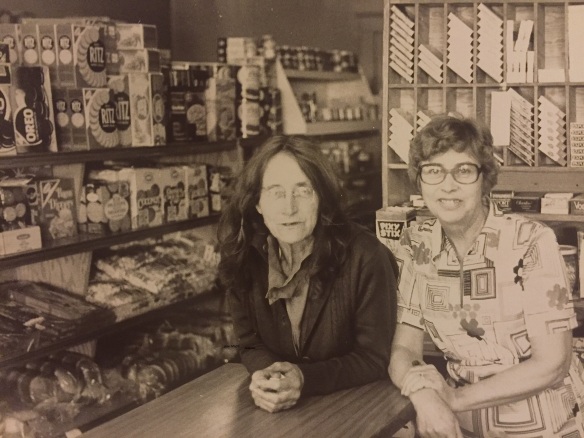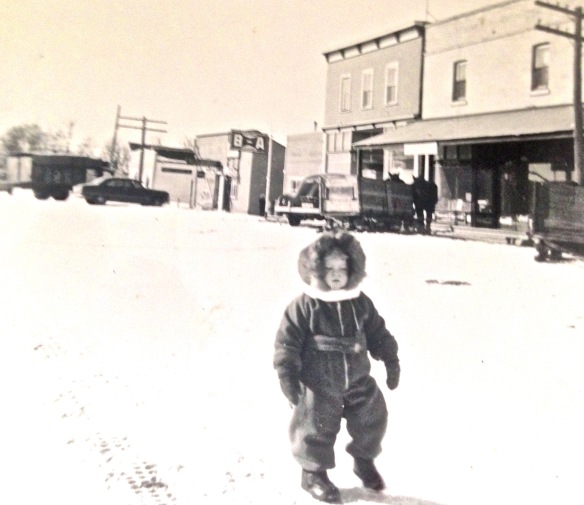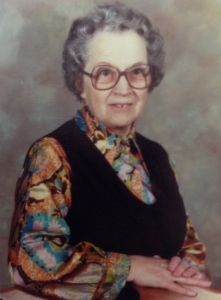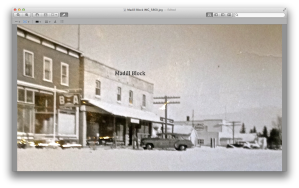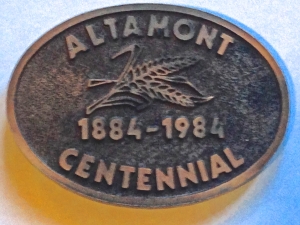In the Parkinson’s Garden: Ruminations on Love, Intimacy and Sex
Preface
It has been quite some time since my last post. I assure you that I have not been idle, just facing a number of challenges which have required close and careful attention. I have been relearning how to walk after losing this capacity quite suddenly over a period of 4 – 5 days in January 2016. As part of this challenge I had a total replacement of my left knee in late August. I am now a little over two months post surgery and have completed my knee rehabilitation physiotherapy program. I have some things to say about the surgery and the rehab as well as the frustration of losing all capacity to walk and not finding a suitable explanation as to why this should happen. However these are topics for future posts.
The biggest reason for the delay, or should I say hesitancy in making my thoughts public, is the sensitive and tricky nature of the subject matter. While the topic has been bouncing around in my mind for quite some time, personal thoughts about sex, love and intimacy are not something that spills onto the page without some considerable thought – especially because my wife and lover will read it with a most critical eye, and rightfully so (see Note 1.)
OK, you might well ask: “Who in their right mind wants to read a blog post on love, sex, and intimacy through the lens of a 67-year-old male Person with Parkinson’s (PwP.) Already I can hear bleats of protest, if not indignation and outrage, ranging from: “Oh God, No!” “Cover your eyes and ears,” “Spare us!” Yikes!” “Lock up your children,” ”Gross,” “You deviant,” “You pervert” and worse. If these represent the tenor of the thoughts going through your mind, then I sincerely hope that I do not live up (more precisely, down) to your expectations.
To be honest, I do have some reservations about embarking on this journey, mostly because my thoughts on intimacy, sex and love have a much greater probability of being misunderstood than my thoughts on many other topics. Still, I tell myself that I am being honest in my approach and it has never been my intention to write a “tell all story” or an exposé on the sex life of a PwP. Those of you who are expecting a titillating account of sexual encounters (creepy, romantic, or both) or have a prurient interest in the sexual appetites, activities and proclivities of those who suffer from chronic, debilitating disease and find ways to overcome obstacles to intimacy and sexual satisfaction, can look elsewhere.
When I started this post, I wanted to write about how sex, love and intimacy are just as important to Persons with Parkinson’s as they are for so-called “normal” people. More precisely, I wanted to write about a “normal guy with Parkinson’s” who
- Has dopamine deprivation such that his physiological and the neurological systems are not playing well together;
- Has so many motor and non-motor symptoms of Parkinson’s that his personality, his essential self, disappears into the visual busyness that is Parkinson’s;
- Has difficulty making his views heard and understood outside of a very small circle of friends and family;
- Desperately wants to deny that the disease is not only advancing but will eventually render him incapable of activities of daily living and totally dependent on others for care;
- Wants to live and feel that complex of human feelings and behaviours we have come to associate with intimacy, love and sex.
Let’s be clear. I am quite sure that any talents I possess as a writer or a story teller will not be adequate to the task of explaining the permutations and combinations of love, sex and intimacy along with the almost infinite number of accompanying human emotions. Nevertheless, I shall do my best to begin this conversation in the only way I know how – using a blend of personal experience, critical self-reflection, knowledge (lived and acquired) , and informed awareness of the issues.
[Please note that I have not included any analyses of the tremendous love and support I receive from my family and friends as it is of a different order of love and intimacy. If anything they should feel relieved by this omission rather than slighted.]
Two particular unrelated events, one hundred years apart, have been instrumental in the formation of my views on intimacy, love and sex, and on my decision to voice them in a public forum.
So, let’s get started shall we?
Eloping: Guns Blazing?
[Love was smouldering in the gardens and orchards ….]
What better place to begin a search for true love than with a story about true love. The time is 1915; the place is Deerwood – a small Manitoba farming community on the rail line between Altamont and Miami; and the key protagonists are my paternal grandmother, the auburn-haired Maud Moorhouse, her father Henry Moorhouse, and my grandfather, Robert Egerton Marshall, neighbouring farmer and “ne’er do well.”

Map showing the proximity of the Marshall and Moorhouse farms
I do not recall my grandparents being wildly in love but obviously there was something smouldering on November 23, 1915 when they evaded the pursuit of the bride’s father to elope and marry in Winnipeg, Manitoba. The story of the elopement has always been told in our family with a certain amount of humour – a story about how Maud (20 years old) and “Old” Bob (15 years her senior) had outfoxed Maud’s father and run off to Winnipeg together. It was pretty racy stuff for rural Manitoba in 1915.
In an undated and unpublished manuscript, Not Because of Beginnings, Dr. H. H. Marshall, the first-born child of the eloping couple outlines the facts of the matter.
“On November 23, 1915, Bob drove his horses the long roundabout way to approach the Moorhouse farm from the Deerwood side, which was mostly hidden from view from the house. A deep ravine crossed the south part of the Moorhouse farm and between the Marshall farm and Deerwood. There were no approaches for three miles to the east but the west approaches could all be seen. While her father’s attention was diverted, Maud walked down through the wooded ravine pasture to meet Bob. They then drove to the railway station at Deerwood, where he had bought tickets earlier. The train was on time and they were on it. Father [Henry Moorhouse] was furious when he learned what was happening but he had been delayed some. He took his good team of horses and a shotgun to follow the elopers but he arrived at the station after the train had left. He tried to follow but was left far behind. Bob and Maud traveled to Winnipeg to be married by Rev. Ridd, a minister who had served at Miami. Henry was forced to accept the situation, although he certainly would have fumed and stormed for some time.”
The story has been told and retold many times over the years (and will continue to be) and each telling will be as understated or as overstated as the teller wishes it to be. Undoubtedly, many of the accounts will contain embellishment in keeping with the storyteller’s character and his/her skills at weaving a good tale. The fun may have been in outsmarting father Moorhouse who would be painted as a gruff old bugger with no love for an underachieving neighbouring farmer almost as old as himself. It could be accompanied with appropriate narrative describing the farming economy of the day and Marshall’s poor prospects coinciding with his decidedly very poor agricultural land, barely suitable for pasture, as the backdrop to Marshall’s desire to spend most of his time on horticulture and fruit growing rather than traditional farming. I have heard some say that he was a “damn poor farmer.” The punch line would be that Marshall’s inclinations were correct and his observations that this land would produce excellent produce led him and Maud to some notoriety as innovators in fruit and vegetable growing and other horticultural pursuits. Not to mention that their genes and the environment they created produced their first-born son Henry who would blaze his own path as an innovator in horticulture. The irony would not be missed in the fact that Henry Marshall was named after his maternal grandfather, and young Henry would soften the gruff old man and become Moorhouse’s (only) favourite among the five grandsons Bob and Maud gave him.
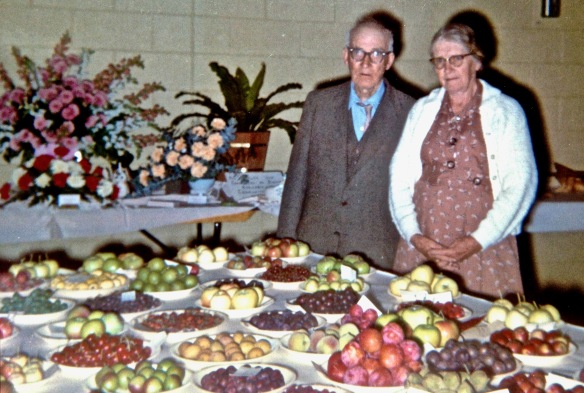
Maud and Bob Marshall with a selection of their produce. Photo: unknown
Or the storyteller might chose to elaborate on the secretive courtship, the ruse, the deception, the chase and the sweet victory of true love in Winnipeg. The collusion and collaboration by those in the know to ensure that the lovers were able to escape the disapproving father required some intricate maneuvering given the communications of the day. The lovers would be trying to leave unobtrusively. Upon learning of the plan Old Moorhouse would run his horses to the sweat trying to beat the lovers to the train, falling just short; guns blazing as the train sped out of sight.
The best stories are ones that are true for the most part but leave the storyteller some leeway to work magic at the edges of the veracity. What is the real story behind the elopement of Bob Marshall and Maud Moorhouse? Who pursued whom before old man Moorhouse pursued them both? Was Maud’s sister, Ethel, a co-conspirator seeing this as her way to avenge her father’s firm refusal to approve her own potential marriage? Who knows for certain? I hope I have the opportunity someday to return to these events so important to my family’s history.
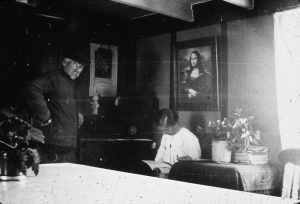
Henry Moorhouse and daughter Ethel c. 1927. Photo courtesy of Western Canadian Pictorial Index, University of Winnipeg Archives
For now, I can only say with some certainty that there was love smouldering in my family’s gardens and orchards in those years and that realization is part of the impetus for me to reflect on love, sex and intimacy from the warmth and love generated within the confines of our present day Parkinson’s garden.
Okay, that is the first reason for writing this particular blog posting. As always, it is best not to charge ahead too quickly without understanding all of the antecedent reasons for proceeding.
Wife/Caregiver Takes a Lover
[The honourable thing may be to face the music and end the charade; just don’t expect accolades or applause.]
Some months ago I read an article that I can’t seem to get out of my mind. In Australia the wife of a Person with Parkinson’s, revealed through a Christmas missive to friends and family in 2015 that she had taken a lover while still living with, and caring for, her husband.
The Australian Broadcasting Corporation (ABC.net.au 2016) aired a documentary called The Three of Us: Carer, Husband and Lover which is about … well … about the three of them. The short story is this: Damian, Elaine’s husband, has early onset Parkinson’s and frontotemporal lobe dementia; Elaine, Damian’s wife and ‘carer,’ takes a lover, Trevor; Trevor becomes Damian’s friend, and lives a few blocks away from Elaine and Damian. Elaine and Trevor, it seems, are fine with this arrangement and she reveals all to the world in a Christmas letter – a commonly accepted vehicle for disseminating information – joyful and sorrowful – throughout the Christian world. This function continues even as social media gallops ahead of the Christmas letter curve primarily because the Christmas letter can disguise itself and hitchhike within the links and attachments of social media.

Christmas letters bring joy and sorrow
I am not sure what to say about Elaine’s letter. Is it a joyful one because Elaine has found happiness and a new love? Is it sorrowful because the marriage between Elaine and Damian has broken down and Elaine has moved intimacy and “romantic love” out … and into another relationship? Is it sorrowful because Parkinson’s and dementia have robbed Elaine and Damian of the opportunity to maintain a ‘real’ marriage (“‘til death do us part”,) with long-term physical and emotional commitment including sex and intimacy? Is it joyful because Elaine has found the wherewithal to carry on as a ‘carer’ fulfilling another commitment in the marriage vows (”in sickness and health”) by providing tender loving care? Is it joyful that Damian and Trevor have established a friendship? Is it joyful for children and/or others in the family who are now freed from the worries of how to provide care for Damian? Or is that sad too?
Interestingly, the hit Netflix series Grace and Frankie has weighed in on the same issue using Alzheimer’s as the disruptive scenario. It is not surprising that mainstream entertainment is latching onto these moral issues as important topics for viewers. After all, millions of people worldwide face this dilemma every day. Grace meets a boyfriend (Phil) from her past. They each have a desire for this relationship to be rekindled when Grace discovers that Phil is still married to Elaine (ironically) who suffers from Alzheimer’s and drifts in and out of reality. Of course, this immediately raises the moral question of whether Grace should date and become a lover to a man still married to, and is caregiver for, his wife – albeit a wife who no longer has her full faculties. Spoiler alert: Grace decides initially that she cannot continue on a path to reunite with the old flame under these circumstances. In a later episode she reconsiders and the relationship continues with a steamy hotel meeting that is interrupted by a call notifying Phil that Elaine is missing. The realities of life with someone with Alzheimer’s hits home and the moral question lays there like ‘a turd on the rug’ as a former colleague of mine used to say. The last I remember Grace is calling the whole thing off … or not.
Wait! The Patient Has a View Too
[Hey! I am inside here, you know.]
Let’s return to the Australian Broadcast Corporation documentary for a minute. Journalist Kirsti Melville takes great care to say that she didn’t expect the husband, Damian, to have a coherent and cogent opinion about the relationship between Elaine and Trevor. However, as the making of the documentary progresses she realized that she was wrong on this score and that she should ask Damian for his views, as he deserved that much respect at least. I personally think that it should have been more than an afterthought but I am relieved that she came to see Damian as a human being affected both by the process and the decision. Quite eloquently, the youngest son expressed his wish that his dad not be “reduced to a list of symptoms,” and Melville seems to have taken that request to heart.
For his part, Damian does seem aware that his relationship with Elaine has changed and that he and Elaine each have a different relationship with Trevor. Damian seems to accept this reality with equanimity in the same way he accepts that his health is deteriorating, that he needs assistance and that life is now better under this new reality than it was previously. Do I sense a hint of relief on everyone’s part here? What if Damian had rejected the new arrangement? Melville concludes the documentary by saying that this is a “gorgeous story.”
As a sentient human being myself, albeit one that has Parkinson’s, the enormity of the sadness I feel whenever I consider the possibility that Anne (my wife and lover) and I would have a relationship other than the one we currently enjoy is so massive that it sends cold turbulence through my emotional self; an icy chill freezes all rational perspective; a numbness deadens sensation in my lips, fingers and hands; and a deafening silence fills a space previously filled with words unnecessary to be said aloud.
It is to be unthinkable, yet it is almost a certainty that Parkinson’s, Lewy Body dementia, old age and worn out body parts, or some combination of those conditions, will upset the apple cart. I am not in the least suggesting infidelity. Rather, I am admitting that changes in physical and mental health bring with them some new rules, and even if a relationship remains emotionally true and intact, it does not remain identical through each moment of time as each year unsympathetically exposes more warts and frailties.
Am I allowed to be sad about these eventualities creeping ever closer into our foreseeable future? Yes, of course. Is Anne allowed to be sad? Yes, of course. But let’s be clear; being sad about the probability of something happening in the indeterminate future is a poor way to live everyday life. It is far better to rejoice in the pleasure of the moment. Uh, oh. Is that too hedonistic? Not for this PwP. I have a pretty good idea about my long-term prognosis and I happily accept any burden hedonism might impose in the short term.
I apologize but unwittingly, I have strayed a little from the main point. Whether we are allowed to be, or should be, sad is not the question. The question is: Are we allowed to move on when (if) a significant change occurs in the conditions within which a relationship lives? That question is not so easy to answer.
On the basis of what you have read so far I wouldn’t blame you for concluding that I think Elaine in Australia is wrong to have taken a lover while caring for her Parkinson’s husband. But to be truthful, I am not sure. What I do know is that I am not qualified to make that judgement. However what I am qualified to do is to ensure that the voice of the person being cared for (the patient, PwP, disabled, person with dementia) is heard and not dismissed as being something other than compos mentis.
No Fighter, Including Muhammad Ali, Ever Went into the Ring Unprepared
[Is thinking too much about bad things a bad thing, or is it just that thinking too much is a bad thing?]
The longer you live with Parkinson’s the more you accept that it is a progressively degenerative disease. It will advance in a predictably unpredictable manner through stages – sometimes slowly and sometimes quickly. You will feel each new symptom, or worsening of old ones, at the very moment that it occurs. You will choose either to ignore or deny the change but no matter how much you put your head in the sand it will wear you down until you accept the change as the “new normal.” You are forced to admit grudgingly that Parkinson’s marches on as inevitably and steadfastly as life itself. You come to understand that Parkinson’s travels incognito for years before it merges with the final steps of life’s journey to reach death, a destination it could not locate on its own.
Oh, there will be “cheerleaders” exhorting you to fight on, to resist, to beat the odds, to delay (or defeat) the advance of Parkinson’s. We all need encouragement to keep active – exercise, cycle, walk, run, swim, box, dance, do physiotherapy, do Pilates, do yoga, sing, play music, write, paint, garden, or do any other activity to keep our minds sharp and our bodies in fine fettle. In combination with diet, medical devices, pharmaceuticals (old and new) medical procedures and surgeries such as DBS (deep brain stimulation) or duodopa intestinal pumps and transdermal delivery systems, physical activity gains a better quality of life for us, over a longer period of time. The problem is: I know that, at the present time at least, I cannot outlive Parkinson’s anymore than I can outlive death, no matter how many cheerleaders there are on the sidelines.
There is a maxim, “We do not die from Parkinson’s but we will die with it” which implies that Parkinson’s is not a cause of death. While it is largely true, it is not the whole of the matter. There are many symptoms of Parkinson’s which appear to aid and abet death at the very least. For example, The Michael J. Fox Foundation claims “the leading cause of death in Parkinson’s is aspiration pneumonia due to swallowing disorders.” In addition to dysphagia we could add depression and loss of balance as other factors leading to death. You may have died of a brain injury when your head hit the ground, but the ‘real’ cause of death was that you lost your balance and fell because you have Parkinson’s.
Why does the maxim “We do not die from Parkinson’s but we will die with it” bother me? Aside from the fact that there is a question as to its veracity, it effectively minimizes the onerous path that Parkinson’s can take you along before you die. There is no cure for Parkinson’s, just as there is no cure for death, and I can expect that my body and/or mind will decline significantly along the way because my symptoms will intensify and multiply. Having Parkinson’s places your life at a point closer to death than it would be otherwise. In other words, you have a shorter life expectancy if you have Parkinson’s.
Many of you will feel that I am being defeatist or depressing (if not depressed.) You would be wrong. If you want to give it the good fight you have to know what you are up against. No fighter, including Muhammad Ali, ever went into the ring unprepared. I am telling you though, that the mental preparation necessary to face the probability of altered personal and intimate relationships is the toughest preparation I have ever had to do, maybe even tougher than facing the physical demands of Parkinson’s itself. The energy and focus it has taken to write this blog post is but a small part of this preparation. There are no blueprints or manuals. The challenges are different for each individual and vary according to stage of disease development.
Of course, many PwP turn to clerics armed with Faith and religious texts or counsellors armed with knowledge from social – psychological studies to provide the strength to buttress yourself against the physical, social, mental and spiritual turmoil you will face. Choose the approach (or more than one) with which you will be most comfortable as you travel on your journey: Yoga, meditation, Pilates, faith, spirituality, religion, love of family, exercise, or any other of dozens of choices, will give you peace and serenity.
I suspect that only the strongest of relationships are long-term survivors of a Parkinson’s diagnosis. After diagnosis it is not long before work colleagues and other friends drift away but they may well have done so anyway, after the workplace connection is broken by long term disability or retirement. Outside of personal intimate relationships, the toughest loss to deal with is the loss of “close” friends who will exclude you because … I am not sure why. Perhaps, your interests and/or lifestyles diverge or they may buy into the belief that Parkinson’s is associated with cognitive decline. In the wake of such losses, I comfort myself with the knowledge that very few people keep good friends for a lifetime even in the most ideal circumstances. Still, these are not the relationships with which I am primarily concerned as my thoughts are focussed on relationships involving love, sex and intimacy.
What Does Baseball Have To Do With It?
[Whatever gave me the notion that people would continue to play fair when they fell “out of love” is beyond me.]

The Major leagues were a long way from our little ball field. Photo: S. Marshall 2015
It might seem trivial at first but when I was a lad of about eight years old, Roy Campanella, star catcher of Major League Baseball’s Brooklyn Dodgers (1948 -1958) was one of my heroes. Campanella broke into the major leagues in 1948, one year after Jackie Robinson broke the colour barrier. Unfortunately, Campanella’s career was cut short by an automobile accident that left him a paraplegic. I thirsted for knowledge about Campanella back in those days but we did not own a television and radio reporting was sporadic in rural areas, although my little transistor radio could pick up faraway ball games on crisp late summer and early autumn evenings after local stations reduced their wattage. Moreover, there was no library in Altamont, Manitoba so my father arranged that I could have borrowing privileges with the University of Manitoba Extension Library from which I could order books to be sent by mail. I recall devouring The Roy Campanella Story by Milton J. Shapiro (1958).
Then about a decade ago I read something about the breakdown of Campanella’s relationship with his second wife that profoundly saddened me. The exact sentence is still fresh in my mind. “Campanella’s wife Ruthie, unable to cope with the loss of physical intimacy imposed by the accident, left him” (see Note 2.) In other accounts I read that she would leave their home in the evenings flauntingly seeking male companionship. For some reason this repulsed me greatly and even though I knew that Campanella had his own share of infidelities over the years, I had great sympathy for him. I am not going to go into a long discourse on this matter other than to say that I was repulsed by what I perceived as a deliberate and flagrant desire on Ruthie’s part to hurt Campanella, a man who could neither fend for himself nor defend himself. I guess this is a variation of the old idiom “don’t kick someone when they are down” and appeals to some sense of “fair play” – that people should not play “dirty.” Is this an accurate interpretation? Probably not and it probably doesn’t really matter to most people, but that is how I felt when my brain first processed this information.
And Then Ruby’s Feelings Must Be Considered
[ … this song will not end with Ruby and her man getting back together.]
The perils of love, intimacy and sex as experienced by Ruthie and Roy Campanella was brought sharply back to my memory in the song, Ruby Don’t Take Your Love to Town written by Mel Tillis and originally recorded by Johnny Darrell in 1967. Waylon Jennings, Roger Miller, George Jones and many others have covered the song but it is Kenny Rogers’ release in 1969 that is accepted as the best version and a blockbuster hit. The original lyrics were about a veteran of the Korean War and his wife, but in the late 1960s people widely believed it to be about the Vietnam War and Rogers’ release of the song was very controversial at the time.
I personally don’t associate the song with either Korea or Vietnam but when I hear those mournful lyrics
It’s hard to love a man whose
Legs are bent and paralyzed
And the wants and the needs of
A woman your age, Ruby, I realize
I cannot help but think of Roy Campanella. Of course Tillis’ lyrics, written for public entertainment and mass consumption, are among the best in a long tradition of ‘hurtin’ country and western music, a mixture of everything good and bad about love and deception. In the end, even the murder of the offending wife is contemplated but that deed cannot be fulfilled leaving … what? … a disabled man helpless; Ruby free to do what she pleases; and a clear indication that this song will not end with Ruby and her man getting back together.
And if I could move, I’d get my gun
And put her in the ground
Oh, Ruby, don’t take your love to town
….
Oh, Ruby, for God’s sake, turn around
In any case, about a year ago I heard Ruby Don’t Take Your Love to Town and I remarked to some friends that I thought it was a terribly sad song. I relayed my understanding of the situation faced by Ruthie Campanella when Roy was left paralyzed and how she couldn’t cope with the loss of intimacy and sought to fulfill those desires elsewhere. Perhaps I have been too quick to criticize Ruthie (and Ruby in the song) because my comments were met with a sharp retort from a female friend, “For God’s sake, get over it! Why shouldn’t she find someone else?”
OK then. There we have it. Or, do we?
Romantic Love
[Unlikely as you may think it to be, some lads hunger for a tender kiss.]
When and where do boys first become aware of romantic love? I doubt if it is when they begin to read the sports pages or gossip columnist stories about sports heroes such as Roy Campanella or in the top 10 pop hits list of the entertainment section. I am convinced it happens much earlier but be relieved that I am not going to go into a psychological exegesis about memories of being birthed or suckling at my mother’s breast as my first formative moment(s). [I am not sure that I did suckle at her breast for any extended time, as breastfeeding was not in vogue during the 1940s and 1950s in Canada.]
But if birthing and breastfeeding were defining moments, I don’t recall it that way – in fact, I don’t recall that part at all. Rather, my first memory of such a thing called love between two humans – a love that was not a familial love but a love that encompassed intimacy – was the love my Uncle Henry and Aunt Eva had for each other, at least as I witnessed it as a child. Yes, this is the same Henry, first-born child of Robert and Maud Marshall after they eloped in 1915. In retrospect I am convinced that my aunt and uncle had a tenderness and a tangible common understanding of commitment that exceeded the norm for most other relationships – I say this confidently as I reflect on my own 60 plus years of study as a participant observer of human behaviour (non-scientific I grant you but observational data points nonetheless.)
As this is not a “tell all” blog post (it is hardly even a “tell something” post) don’t expect me to go into great intimate detail of my uncle’s and aunt’s lives spent in love, other than to say that there is something about a chance observation of a noon hour kiss on the lips, a genuine tender kiss, neither a peck nor a slobbering, groping tonguing, that left this small boy entranced, longing to know the secret to such an uninhibited demonstration of love. I witnessed this portrayal of affection many times in my formative years when my uncle would arrive home for lunch, having spent the morning in the gardens and greenhouses of the Brandon Experimental Farm. On occasion they were a little more demonstrative and disappeared into their bedroom for some cuddle time. I spent a few weeks each summer at the Experimental Farm with my cousins and the expression of genuine affection between my aunt and uncle never changed over that time. Low key, long term, lasting, love. What I witnessed was neither titillating nor tawdry but it was a powerful introduction to what I believe is the most powerful of human feelings.

Henry and Eva Marshall Photo credit: unknown
It seems that my remembrances of my aunt’s full bodied gentleness, my uncle’s strong gardening hands, and their lips caressing in a short soft noon time kiss create the ideal segue for me to talk about love in our present day garden.
My Love Affair With Roses
[Thorny as they may be, it is impossible to plant a rose without giving it a hug. See Note 3]
Some might say that the men (and some of the women) in my family loved their gardens and orchards more than they loved their women (or men.) I like to think, somewhat selfishly I suppose, that the quantum of love is equal in each case and this is perfectly in order as long as the love for your human lover is of a magnitude required to sustain the relationship over a lifetime.
This history of love for gardens and orchards in my family may go some distance to explaining why I seem to be having a love affair with roses this past year. It is not entirely surprising that roses should seduce me now. Oh, we have always grown a few roses, mainly those developed by my uncle, Henry Marshall, who was instrumental in developing the Parkland series of roses at the Morden Research Station (see Note 4) but to say that I was crazy in love with roses before this year would be incorrect.
There is no doubt about it; this year is different. I now have a full-blown infatuation, or dare I say, fixation, or maybe obsession, with some specific species and varieties. Under normal circumstances one might interpret such a state of mind as being one of great joy but in the sanctuary of my garden, alone with my innermost reflective thoughts, the joy of being so intimately close to a beautiful rose that her love bites are evident in the sanguineous contrails on my arms, is often tinged with the sadness of knowing that my desires are partly the last ditch efforts of this gardener (the PD Gardener) to experience as completely as possible one of the most sought after perfections of love – roses – before he is no longer capable of the husbandry required for them to flourish and the mental acuity required to bask in the romance and intimacy that they proffer.
Not surprisingly I guess, I have been reflecting mightily upon life and love, especially life and love in a world with Parkinson’s disease, my constant and most abusive companion. I have come to look to the rose, iconic as it is of love, to override the ravages of Parkinson’s, to perfume the ether for lovers whose wings take them to those lofty heights, to provide the beauty that is in the eye of the beholder. I desire desperately to be in that select category of “lovers” known only to poets, song writers and composers – you know those romantics who make you want to hurl your stomach contents into the shrubbery and who, at the very same time, make your insides come alive with butterflies of anticipation as you sense the presence of a new lover. [The difference between literary excellence and soap opera cheesiness gets a little muddied sometimes.]
It is small wonder then that this is the year of my love affair with roses. For this year I crave reassurance in all matters of love, especially as the staccato ‘rat-a-tat-tat” and “thrum thrum” of the advancing drums of Parkinson’s often obscures mellow intimate tones, and may even cause them to flee. The Parkinson’s drum corps is relentless in exhorting the destruction of the final few neurons capable of dopamine production. It has been a difficult year with many health challenges nipping at my heels at a time when I maybe won’t be kicking up my heels quite so much in the near future. I desperately hope this prediction is not the case and that The PD Gardener has many more years of flirtation with flora of all species.
In my sanctuary, in my garden, I stay the course, gather my strength and turn a deaf ear to Parkinson’s heartless beat. The garden works a therapeutic magic, magic so strong as to suppress temporarily the tide of muscle movement disorder and non-motor symptoms. It grants me peaceful interludes to reflect on my family and good fortune. In the garden I am mostly a labourer, often a gardener, sometimes a landscaper, occasionally a naturist, once in a blue moon a horticulturalist, frequently a social historian, and always an amateur philosopher. I know deep in my heart that each role cannot save me, individually or collectively, from Parkinson’s. But these roles, individually and collectively, provide vehicles through which flora in general and roses in particular (at least this year) seduce me into accepting that, even outside the garden, I am loved as much or more than I love.
Having a new desire, a new focus for your attention, is an important part of the seduction. There are many new roses on the market making a trip to the nursery even more exciting than usual. I find myself hanging around the rose sections of various garden centres, surfing the Internet for new information and photographs, and being distracted anytime I come near a rose. I have relentlessly pursued some varieties, unsuccessfully as it turns out, until my children hooked me up on blind dates.
To be clear, my affections run strictly to shrub and rugosa roses. I have little interest in tea roses or other roses that I consider high maintenance and finicky. And if it is not hardy to our climate (zone 3 or possibly 4 in some isolated micro- environments in our garden,) I don’t have much use for it either. I am not a protective kind of guy when it comes to roses in winter and I leave them to fend for themselves no matter how severe the weather during those months. They live or they die. If they die I am sad of course but I accept no blame – winter is winter and largely beyond our control. Oddly, I do become more protective when it comes to hot weather or arid conditions. I do want the roses to survive heat waves (and we seem to be having more of these periods as the planet heats up.) I will water roses to keep them healthy and to ensure that they bloom profusely.
It is not easy to describe my love affair with roses but let me try by describing some romantic interludes with several “Rosa.”
Rosa x ‘Oscar Peterson’
I had my eye on several young roses but it was Rosa x ‘Oscar Peterson’ who lured me into a tantalizing, thorny and crazy love affair. This newest rose in the Canadian Artists Series is named in honour of jazz great, Oscar Peterson. I know, Oscar Peterson is male and I am not gay so what is the attraction? In my world, roses are always referred to as being female but in fact, roses are hermaphrodite plants i.e., they have both male stamen and female stigma on the same flower. Monoecious plants have separate male and female flowers on the same plant, and Dioecious plants have only one flower, either male or female, on each plant. Consequently feel free to refer to roses as female or male as is your desire.
Rosa x ‘Oscar Peterson’ is not shapely but is an almost compact square at 1.5 meters x 1.5 meters. Its buds emerge with the colour of Creamsicles (one of my favourite childhood treats) before maturing into pure white blooms with yellow stamens – no less inviting.

Rosa x Oscar Peterson Photo: S. Marshall 2016
Oscar Peterson’s developers were clear in their evaluation of the rose that it met the standards of excellence exemplified by Oscar Peterson as a musician and they encapsulated those thoughts as follows:
“Oscar Peterson’s music was seamless, as if it flowed from his fingers like a spring of clear water. Those who understand music know that such perfection is the result of hard work and endless practice.”
“It is fitting that the new ‘Oscar Peterson’ rose has attributes of perfection. Its flawless, deep green foliage acts as a perfect foil for blossoms that appear as if from a never ending floral spring. These glossy leaves are the result of the hard work and patience of generations of breeders who have worked to create roses with superb hardiness, disease resistance and great beauty.”

“The semi-double flowers begin life in a shade of softest yellow cream, especially in cooler weather. Often the tips of the petals are lightly touched by red. Soon cream turns to glistening bright white and a contrasting boss of golden yellow stamens. The flowers are arranged in sprays, and, like a musician who finishes his set with style, the petals drop cleanly away once the show is over.”
Far be it for me to attempt to wax more poetic than the above passage to explain why this white rose should be named for a Canadian black musician whose music captivates our minds and captures our hearts, rendering us defenseless to resist its charms. The subtlety and simplicity of the melody cavorting with the complexity of the phrasing plays delicately upon our emotions equally as much as it plays with our emotions, lifting us to the very height of hopefulness, far away from the din of despair. Don’t believe me? Listen to Night Train (released in 1962) the landmark album of the Oscar Peterson Trio (Peterson, Ray Brown and Ed Thigpen.) https://www.youtube.com/watch?v=Dyip9jykZ7o
For me, this is enough said. However, others who are more closely attuned to the sociological phenomena of race, culture and inequality have voiced their view that it is appropriate that the rose named for Peterson is white as it fits his blend of jazz – ‘White’ and not ‘Black.’ Others attribute this white rose faux pas as yet more evidence of a white culture’s ignorance of the racial dynamic. I fear this horticultural and socio-cultural debate will have to await another occasion – perhaps when another of my favourites, Erroll Garner’s Concert by the Sea, can be introduced into evidence.
Rosa x ‘Emily Carr’
I really must apologize as I intentionally told you a little “white” lie in the previous section – Rosa x ‘Oscar Peterson’ was not my first dalliance in the Canadian Artists series. About three years ago we came upon Rosa x ‘Emily Carr’ with her clusters of deep red blooms calling out for your attention at all hours of the day … and night for that matter. While she is advertised as being wider than she is tall, in our garden she sends up canes 8 feet tall (almost like a climber) on which she proudly displays clusters of gorgeous blooms continually through the hot and steamy summer. Surprisingly though she does not rest until a hard frost halts her in her tracks.

Emily Carr Photo: S. Marshall 2016
“You come into the world alone and you go out of the world alone yet it seems to me you are more alone while living than even going and coming.” ~ Emily Carr
Such a bleak picture to paint. Being alone is a complete package from birth to death and in between. It can be a sad thing but it need not necessarily be so and we often choose to be alone at various times in our lives. Indeed, we are often happy to be alone at those times. Being lonely though is a different matter and is by definition sad as it means the soul is not being nourished. I am not a religious person so I will resist the temptation to speak of faith in a Supreme Being as nourishment, but I know for a fact that the “quiet nothingness” of a loving relationship with another sentient being is indeed nourishment for my soul. [I will elaborate more on “quiet nothingness” later.]
“Be careful that you do not write or paint anything that is not your own, that you don’t know in your own soul.” ~ Emily Carr
This is a most difficult stricture to follow but I have to say that, even as a want-to-be author, when I do know something in my soul, the words fly off my fingers as if by ordinance finding their place on the page even before meaning, context or content is fully fleshed. Conception and birth occur in one singular flash and there is no room to be alone in that moment of spontaneous combustion, that instance of chemical reaction, that indefinable electrical spark giving life to foggy neurological pulses within our brains.
However, if you have been fortunate enough to know that “quiet nothingness” of love “in your own soul,” you will spend your lifetime searching for ways to express it. I have no intention of competing with Elizabeth Barrett Browning’s straight to the point question in Sonnet 43 How do I love thee? (see Appendix A.) Let me count the ways, of course. But that is exactly what knowing love in one’s soul should be. While the letters may fly off my fingers, I still search for words, phrases and punctuation to convey the perfect image for love. I invariably fail as my talents as a writer are woefully inadequate to meet the task. I do not possess otherworldly attributes necessary to paint the page with words that would liberate love from the constraints of a Parkinson’s world where one’s soul, no matter how willing it is to being a host for love, is rarely sought out for that purpose.
Rosa x ‘Hope for Humanity’
It was in a previous quest for a rose to represent Jean Madill, a centenarian from Altamont, Manitoba, that I began to explore the depths of the new roses. “Hope for Humanity” attracted my eye not only for its beauty but for the political statement that she makes – it is uncommon for the names of roses to be overtly political but Dr. H. H. Marshall did not shy away from politics when he named one of his roses, Adelaide Hoodless, an early suffragette and feminist with both conservative and progressive tendencies which was not uncommon for women of her time.

Rosa x Hope for Humanity Photo: S. Marshall 2016
Oh, There Were Others, I Confess
[… and they are all named Rosa ….]
I am afraid that there were others on whom I showered my affections and with whom I spent more than a few afternoons cavorting in the dappled shade of the garden; a few mornings frolicking with my toes moist with dew; hypnotized in cold early October by silvery ‘pre-crystalline’ raindrops on leafy vestments; hungering in early summer for the sweet nectar enjoyed by their rotund Apis mellifera lovers but forbidden to me; caressing the softness of their blooms whilst striving (unsuccessfully) to avoid the bloodthirsty thorns protecting their bodies; being intoxicatingly dizzy from the fragrance of forbidden love in the dusk of the day (or perhaps it is intoxicated by their dusky fragrance at any time of the day.) I say this unashamedly as I now admit openly that I have succumbed to their big city, sophisticated, hybridized ways.
Should I name names? I am not going to go into great detail about the attributes of all of these loves, all named Rosa, as it will be too time consuming, but there are several that deserve more attention. See Appendix B for still others.
Rosa x ‘Campfire’
‘Campfire,’ named after a famous painting by renowned Canadian artist Tom Thomson, was released in 2014. The description on the Canadian Artists series website pretty much says it all.
Campfire, the painting , shows a fire burning in front of a tent lit inside by a brilliant yellow light. It is a masterpiece of design and colour. The rose ‘Campfire’ is afire with the same smouldering blend of yellows and reds.

Rosa x Campfire Photo: S. Marshall 2016
Rosa x ‘Campfire’ shows a profusion of blooms with colours that are both bedazzling and mesmerizing. Of course I am drawn back to my childhood and the many times I stared into the flames of a campfire while camping, at a family “wiener roast” or at the teenage triple X rated (for offensive language, drunkenness, overt attempts at sexual activity however inept, and outright teenage stupidity) version of a wiener roast. No matter the context, you cannot help but be drawn into Campfire’s flames where your desires, excited by the heat, race through your arteries in a desperate attempt to carry oxygen to the “smouldering” coals, freeing any inhibitions. If you place ‘Campfire’ within the context of sex, love and intimacy, its mass of blooms might very well conjure up the word “orgy.”
Rosa x ‘Bill Reid’
Rosa x ‘Bill Reid’ is a rose I longed to acquire because we had no surviving yellow or gold roses in our garden. A small yellow tea rose did not survive the winter a few years ago leaving us without the sunny spectrum. ‘Bill Reid’ is named for a legendary broadcaster, writer, poet, storyteller and communicator who introduced much of the world to the art traditions of the indigenous people of the Northwest Coast.
“His legacies include infusing that tradition with modern ideas and forms of expression, influencing emerging artists, and building lasting bridges between First Nations and other peoples.”
“He combined European jewellery techniques with the Haida art tradition. His passion for Haida art was kindled by a visit to Haida Gwaii in 1954 when he saw a pair of bracelets masterfully engraved by the great master carver and his great-uncle, Charles Edenshaw, after which, to use his own words, “the world was not the same”. For the next 50 years Reid embraced many art forms. His many powerful sculptural masterpieces include The Raven and the First Men, the Haida creation story, and The Spirit of Haida Gwaii, showcased at the Canadian Embassy in Washington, D.C. and at the Vancouver International Airport.”
“The Bill Reid rose is reminiscent of the medium the artist Bill Reid often used: gold. The rose itself has a vibrant golden hue, which it retains even under the strong rays of the summer sun. The colour denotes energy, warmth and vitality. And much like the artist, the Bill Reid rose flowers prolifically, more so than other yellow roses. In true Canadian fashion, this rose is hardy to zone 3.”
Needless to say I was thrilled to come across Bill Reid, quite by accident, at the garden centre. In fact, it was early one Monday shortly after opening, and I was at the cash when a supplier for the nursery was unloading a small wagon load of roses. There was Bill Reid, tucked in the back of the wagon, in full golden glory highlighted by the early morning sun. I asked if it was for sale and was told yes but it hadn’t been priced yet. I was unconcerned about the cost as I was smitten with it from first sight and after the business dealings were completed I whistled my way home excited by the knowledge that I would soon hug Bill Reid and position him in a suitable sunny spot.

Rosa x Bill Reid Photo S. Marshall
Every once in awhile there are love affairs that remind you that the course of young love does not always run smoothly and that you should be cautious, especially in the early stages. So it was with Bill Reid. It was not long before I noticed some vile critters inhabiting Bill’s foliage and blooms. They looked very much like the Japanese beetles that have a voracious appetite for soft rose petals. Immediately I began the ugly process of picking the beetles off and depositing them in a solution of detergent and water. As I write this, I have quite a horrific soupy mess in that container. My objective is to contain the invasion although I have discovered that the beetles also love Canna leaves and Lythrum flowers. After several days my picking finally slowed down but I am realistic enough to know that an infestation will be avoided only if my neighbours are as diligent as I am in harvesting the little buggers (a word my father would definitely use in this circumstance.) To make matters worse the Japanese beetles dine on some 200 different species of plants. I will make every effort to avoid using pesticides.

Japanese Beetle Photo: Wikipedia
The meeting and courtship of Bill Reid was quick, easy and intense. However, as is often the case, inattention to certain health matters may strain the relationship in the short term if not in the long term.
Rosa x ‘Marshall’s Peace Garden’
Rosa x ‘Marshall’s Peace Garden’ is a ‘sport’ of the popular Morden Blush, bred by Dr. H. H. Marshall and a favourite of ours for many years. I am counting on Marshall’s Peace Garden to capture my heart and make me blush with its abundant creamy white flowers and glossy foliage on a tiny 2 ft. x 2 ft. frame. I am told that it has a wonderful fragrance but as I have Parkinson’s most of my sense of smell disappeared long ago. Listed as hardy to zone 2 there should be no winter-kill problems in our area.

Rosa x Marshall’s Peace Garden Photo: S. Marshall 2016
My particular affinity for Peace Garden stems from the fact that it is named in honour of my uncle Henry who was a member of the Board and Horticultural Planning Committee of the International Peace Garden (see Note 6.) Peace Garden was propagated by Terry Roszko, Canada, circa 2000 and introduced commercially in Canada by Jeffries Nurseries Ltd. in 2012 as Marshall’s Peace Garden Rose. In fact, the specimen that I planted just this morning was a gift from my daughter and her partner who made a side trip to Jeffries Nurseries while visiting family in Manitoba, carefully bringing Peace Garden’s spiky fullness as carry on luggage on their flight home. I had been trying to source Peace Garden locally without success. When my daughter and her partner surprised me by introducing Peace Garden on a blind date if you will, the excitement of meeting this unexpected and beautiful rose was palpable.
Sex, Love and Intimacy
[Put sex, love and intimacy together in one human relationship and ....]
OK, enough with the roses. Back to the main topic. Many people are too shy, inhibited or embarrassed to talk openly about sex, love and intimacy, preferring to keep such information close to their vests or perhaps close to their hearts? Others succumb to a commonly held societal belief that these emotions and thoughts are “dirty” and not to be discussed “in polite company.” Still others would allow that only researchers with a PhD in psychology and a specialization in sexuality be permitted to explore these basic elements of human instinct, analyzing and discussing it in ‘academic – speak.’ Heaven forbid we should actually feel something.
Sex, love, and intimacy are three of the most important words in the language of relationships but I suspect that they are three words often shunted to the sidelines because, when spoken aloud, these words cause us to be awkward and self-conscious about what we perceive to be personal and private matters. Yet, love, intimacy and sex make sense only in the context of a relationship between at least two individuals so absolute privacy is automatically abandoned upon the necessary formation of a single dyad (sounds like an oxymoron.) In other words, by definition, there is always someone else who has inside information on your love life, your comfort level with intimacy, and your sexual proclivities. So, let’s not get too hung up on an argument that personal and private matters are … well… personal and private, belonging only to ourselves as individuals.
It is also the case that love, intimacy, sex are often compartmentalized and treated each unto itself as a separate concept, with separate meanings and a separate set of feelings … and sometimes they are distinct. Language, being the primary vehicle for discourse among humans, must possess a certain precision that enhances understanding. But surely that does not mean that we must always drill down in a reductionist way to the most infinitesimal element. Having said that, while it is true that a convincing argument can be made that love, intimacy and sex can be defined individually, it is only when these three powerful human emotions and behaviours are put together in a ‘mash up,’ as younger folk say these days, that the truth is revealed. They are really individual recognizable segments of something that is greater than the sum of its parts. Regular readers will recognize this as a recurring theme in my posts – society is greater than the sum of its parts. I blame it on Emile Durkheim and my training in sociological theory.
Let’s complicate things just a little more by adding that in today’s world much emphasis is placed on the use of “clear language” in an attempt to cut away the superfluous, to enhance communication so that ideas can be discussed with equal precision among all participants irrespective of class and other social or economic divisions. I understand the necessity for clear language in many situations but I don’t subscribe to the “clear language is always better” approach. I believe that it takes many levels of discourse to understand the complexities of life. Oh sure, sometimes language is frustratingly complex, unnecessarily obtuse, and gratuitously verbose but a living language will evolve both to smooth out the rough edges of precision and to give precision to the softness of fuzzy articulation. The aggregation of several meanings into one concept or construct is one such smoothing technique which allows language to reach precision through a higher level of discourse.
Let me illustrate it this way: put love, intimacy and sexuality together in one package in the entertainment industry and you have a blockbuster hit rocketing to the top of the charts – “number one with a bullet” as DeeJays used to say. It will hit the jackpot, be a winner, a jewel, and ‘toadilly awesome.’ It will also, most likely, be fiction. But put love, intimacy and sex together in one human relationship and … well … (thinking … thinking … thinking)… there are no words …. and it (the love, the intimacy and the sex, individually and collectively) will inevitably be real – often sought, rarely realized.
I know, you are thinking, “The PD Gardener is off on one of his tangents again, spouting off about things of which he knows nothing.” Hmmmm … maybe, maybe not. Stay with me to find out if I can tie up this seeming stream of consciousness with a pretty bow.
Love is “Quiet Nothingness”
[ … a life free of drama …]
Image from Wikipedia
Obviously I am not the first to have contemplated the complexity of sex, love and intimacy and the importance it plays in our lives. Cheryl Saban has a series of short posts on the topic that are worthwhile reading. I am not going to summarize her thoughts but I will draw your attention to a couple of specific observations. The first of which is that she is writing from a woman’s perspective when she observes that a female’s sex drive is more than just survival instinct.
“As a species, our sex drive is a survival instinct. But as a female, your sex drive is obviously more than an instinctual need; it’s wrapped up in feelings of comfort, love, companionship, excitement, naughtiness and hope.”
Well, I have news for you; these feelings are not reserved for females alone. Still, I suspect that in my early, more macho male life, my desires and emotions were not anchored in this approach. I had a process of maturing to go through, including a divorce and a somewhat painful but finally fruitful search for my – Gawd, I can’t believe I am going to say this – “soulmate.” As much as it pains me, I will leave the forgoing sentence in tact as “soulmate” does have meaning in romantic discourse to most people and that is that common understanding I wish to convey here. But there is more. In fact, what I was searching for and what I found was a relationship where love, intimacy and sexuality are in a state of ‘quiet nothingness.’ [Okay, I am counting on you not to shout “drivel” and hit the escape key to exit this nonsense. Please bear with me.]
Do not take this literally to mean that sex, love and intimacy are nothing because it is impossible to conceive of “nothing” unless we also acknowledge the existence of “something.” Put differently, we can approach a state of “nothing” but we cannot achieve a state of “nothing”. To approach “nothing,” “something” is minimized or simplified to its most basic ‘somethingness’. I like to think of it as an expensive sound system with a complicated soundboard where all the elements of great sound are captured but everything is turned to its minimal reading. We hear nothing but the lights are lit and flashing. Intimacy, love and sex are in “quiet nothingness,” simmering, occasionally showing energy genuine to each element but always at the ready to arouse positive emotion. The simplification and minimization means that the relationship is held in tact with little work. Achieving this state of “quiet nothingness” is to achieve a state of togetherness of two minds and bodies, perhaps analogous to Zen. A key descriptive phrase for me is “free of drama.” I have been truly fortunate in that I know first-hand what that state of mind and body feels like … but it can be fleeting if one is not careful.
It is no secret that the soundboard controls the eruption of displays of energy from time to time. When such energy is incorporated into the structure of the music for example – as a bridge, a chorus, refrain, verse, coda (or in any other creative way) – the music and the sound can approach such perfection that only a highly trained ear can detect the subtleties defining it as otherwise. It is the same with the “quiet nothingness” of love … flying low in stealth mode beneath the radar … lethal in its efforts to target and destroy thoughts and behaviours that inhibit intimacy, and … complicit in bringing to life a sexuality which would be declared illegal by those who have not experienced “quiet nothingness.”
Parkinson’s is a Troubled Dance of Rationality and Irrationality
[“The only thing we have to fear is fear itself ….”]
Parkinson’s is such a complex of motor and non-motor symptoms that in its early stages we often overlook symptoms related to our psychological well being e.g., it increases anxiety and stress, plays with our emotions and leads us towards feelings of depression and sometimes despair. So we begin a troubled dance between rational and irrational thought especially when it comes to love and intimacy.
I reason (rationally and correctly I believe) that the further I travel along the Parkinson’s road, the greater the probability that the usual nasty features of Parkinson’s including Lewy Body dementia will compromise my ability to sustain an intimate relationship. How tragic that would be! But let me be clear: as I write this there is no tragedy in my life and each day is replete with reaffirmation of my love for Anne and her love for me. Still, even the most serene individuals have anxieties and are susceptible to irrational thinking from time to time. Parkinson’s provides sustenance for those anxieties, keeping them on a slow burn until fear and insecurity blows them out of proportion.
Fortunately most anxieties are relatively minor and can be handled effectively with planning and successful experience e.g., anxiety about how Parkinson’s will behave when traveling or when attending a special event. Other fears are more serious e.g., a fear that your Parkinson’s creates an unbearable burden for your spouse, partner and/or lover leading to a tragic end to an intimate loving relationship. In matters of the heart the emotional roller coaster of Parkinson’s can entice you into jumping too quickly and erroneously to that conclusion. In fact, insecurities may spawn unacceptable jealous behaviours that put enormous strain on intimate relationships, perhaps to the point of breakdown.
You might ask the question: Why would a PwP want to destroy happiness and contentment and replace it with a tragic heartbreaking ending? Rationally, there are no compelling reasons to do so but when you are trapped in the world of irrationality where Parkie lives, fear can become an almost crippling burden, and if we are not careful, it can become a self- fulfilling prophecy.
Perhaps Sir Francis Bacon was correct when he wrote “Nothing is terrible except fear itself”) or maybe we should attribute it to Franklin D. Roosevelt, the 32nd President of the United States, who said in his first inauguration address on Saturday, March 4, 1933
“… let me assert my firm belief that the only thing we have to fear is … fear itself — nameless, unreasoning, unjustified terror which paralyzes needed efforts to convert retreat into advance.”
Parkinson’s disease is a fearsome thing. It can strip you of every dignity at a moment’s notice if you are not attentive to your medical, pharmaceutical, psychological. dietary and physical regimes. It is not stretching it to say that Parkinson’s plays a wicked game of chicken with you in your social relationships. It dares you to consider that it has not diminished you. Maintaining your mental strength in the face of such a challenge is extremely difficult because you notice and feel any newly acquired Parkinson’s symptoms so acutely that you are certain the unreasonable demands of your Parkinson’s are denying your spouse, lover, partner a full and complete life. The threat to the viability of your relationship is real and you take full ownership of that ‘failure’ because it is your Parkinson’s disease that is responsible.
Not only is the PwP responsible for the burden but the onus and indeed the impetus is on that same PwP to “free” her/his lover so that s/he may leave the relationship (or any part thereof) to pursue a full and more complete life elsewhere, maybe with someone else. Voilà, guilt free extraction from a life of burden for which you ‘did not sign up.’ Okay, maybe there is some guilt but it is ameliorated by a complex of rationale and justifications. These fears and insecurities are real to a PwP … well, they are real to me anyway.
Facing a life with Parkinson’s alone is extremely difficult. Facing those travails as a couple in an intimate relationship or as a family can make the journey more tolerable but it also means that the path may grow bumpy if one of more of those individuals go outside the understandings of the others. If the commitment is love and the understanding is that love is sexual, intimate and forever, and one individual no longer accepts this commitment, the whole deal goes sour – sometimes very quickly.
I am in a loving relationship and I would never say that my lover should end it because I have Parkinson’s. Why would I be so foolish? We have a love that is exquisitely painted, as if the muse was in full control; a love with great swaths of colour and texture like fields of lupins strewn in purposeful abandonment by Mother Nature; a love brushed into place with the precision of computer technology and the creativity of the Group of Seven.

Mother Nature’s portrait of a field of Lupins Photo: S. Marshall 2014
It is true that Anne does provide care for me … but she does not identify herself as my caregiver nor do I want to reflect her role back to her as that of being a caregiver. Anne is my wife and lover. It is also true that I thank her every day for her support … but I am most thankful that we share a love that is not rooted in caregiving. My greatest task is to return her love by projecting myself as her husband, lover, friend and not as her patient or worse, as her burden. Maintaining and strengthening relationships is much easier if one can avoid using pathos as the glue that holds the relationship together.
Relationships and Adversity
Okay, so far so good, but the bad news is that “quiet nothingness” is not impermeable and there are many threats to its fabric e.g., a diagnosis of a terminal or chronic disease not only changes how you perceive yourself but how others perceive you. This certainly has been my experience after a diagnosis of Parkinson’s disease – a progressive neuro-degenerative disease for which there is no cure. Oh, there are medical, pharmaceutical, physiotherapeutic, psychological, and exercise/movement programs designed to enhance quality of life but inevitably your life will take a path that you would not choose if you had a choice. The rules of the game for relationships may change and the potential for increased tension and stress increases along with a concomitant likelihood that “drama” will result.
When a relationship is under stress you might think that the survival instinct would kick in to override any “soft” emotional feelings, but that is not what happened to me. By the time of my diagnosis of Parkinson’s, I was in my mid – 60s and procreation was far behind me. I already had four perfect daughters in a perfectly blended family.
When I attempt to isolate the key factors contributing to my emotional well being, I am hard pressed to come up with any that are more important than feelings of self-worth. You see, Parkinson’s robs you of your sense of self-worth; it diminishes you. Like a thief in the night it silently robs you of your ability to be the strong one in a relationship. Ironically and wickedly, that same attack on self – worth robs you, as a person in need, of the ability to accept assistance and care, and you can lash out at those who care the most; those who love us; those with whom we have intimate relationships.
If you do have an illness though, life and relationships can change drastically. Karl Robb sums it up this way,
“Realize that an illness can either help bring you and your partner closer together or push you further apart, depending upon how well you are able to cope with challenges and the strength of your bond, prior to illness.”
I am not as charitable as Robb in that I don’t think that Parkinson’s brings many people closer together, at least not in the long term. There is no cure. It is progressively degenerative and it will advance in both the number and severity of the symptoms. No matter what some people say, you cannot delay its onslaught forever. It will catch up to you, one way or another.
Indeed, my perception is that if you and your partner didn’t get along well before your diagnosis, it is a good bet you won’t get along any better after diagnosis and certainly not after nasty symptoms or side effects of the drugs begin to rear their ugly heads – dementia, dyskinesia (exaggerated involuntary muscle movements which are often the side effect of the drugs,) cramping, difficulty swallowing, loss of balance resulting in falls with injuries, incontinence, constipation, rigidity, Bradykinesia (slowness), decreased sexual desire and increased sexual dysfunction, hallucinations, violent lashing out during vivid dreams, and loss of the ability to conduct activities of daily living, to name but a few. None of these symptoms are known to increase the likelihood of developing an intimate relationship if there is no prior history of such a relationship between individuals. Parkinson’s works against you every step of the way.
The Importance of Intimacy
[As we slide closer to each other, my lover whispers provocatively, “… and she felt the gardener’s work roughened hands on her skin …”]
When Parkinson’s destroys intimacy in a relationship, it wins. You slip from being lovers to being caregiver and patient, a misstep (in my view) that changes how each person perceives the other person and in the end destroys any sense of self-worth a PwP has remaining. Once the non-PwP in the relationship believes that intimacy, love, sex (and sexuality) are no longer important in the relationship, the gig is up. I hasten to point out however that the same is true if a PwP is no longer is invested in maintaining an intimate relationship with her/his partner.
Cheryl Saban describes succinctly just how important romantic intimacy is.
“Romantic intimacy and the idyll of two people bonded in love, that most sacrosanct of emotional states, is something most of us desire and in fact, need. Love is a crucial part of our lives, connected as it is to our sense of well-being and worth. The blend of love and sex requires commitment, a special type of chemistry between the two of you, and an ability to build intimacy.”
Intimacy is a word that is both innocuous and intimidating. At first glance, it seems to be something less than ‘love’ but upon closer examination it is a keystone in the foundation of close relationships. Being intimate with someone, while not the same as being in love, is something we are likely to experience with very few others in a lifetime … if we are so fortunate.
Jonathan Lenbuck in “How does sex differ from intimacy,” defines sex and intimacy in ways that I find very helpful to understand the role Parkinson’s plays in relationships.
“Intimacy is at the heart of a strong relationship. Intimacy is about knowing someone deeply and being able to be completely free in that person’s presence. It is an emotional state that is often reserved for just one person.”
“Being intimate with your partner requires you to be open and honest with him or her, and it is from this state of intimacy that great sex grows. This can sometimes be a hurdle in a relationship.”
Undoubtedly, young onset PwP are at a time in their lives when dating and sexual relationships occupy proportionally greater space in day-to-day relationships compared to those of us who are diagnosed in our 60s and heading into our 70s. A reduction in the amount of time, effort, money, etc. put into a sexual relationships is likely for those 60 years of age and older, but don’t ever fall into the trap of believing that it occupies no space in those relationships. On the contrary, love, intimacy and sex may be more central to living a healthy life with Parkinson’s (is that an oxymoron?) than we think. Hopefully some of us have found a relationship that satisfies our physical and emotional selves. I was going to say that some are patiently waiting for such a relationship but it is more likely that they have given up the quest, giving in to impatience rather than patience, resigning themselves to never finding this nirvana. Some are living in relationships devoid of love and intimacy (and probably sex) but do not take measures to change. Some of us live a bittersweet existence with memories of the ecstasy of being in love and the heartache of a life gone too soon.
Pay Attention
[Be careful, the rules can change…]
Parkinson’s changes the rules of intimacy. The inability to show emotion (particularly laughter) through facial expression, (the “mask “associated with Parkinson’s) can change the dynamic of a relationship which relies upon knowing and almost invisible facial cues and eye contact. Involuntary muscle movements can make even simple loving actions such as hand holding or cuddling impossible or so difficult as to be frustrating for both you and your partner. The excitement of close sexual contact – so thrilling and rewarding in the prime of your life – is often turned cruelly against you, as if your Adrenalin has been turned on to hyper speed, increasing debilitating involuntary muscle movements and rendering both intimacy and sexual gratification unattainable. Such frustration can exacerbate issues of erectile and sexual dysfunction already prevalent in Parkinson’s.
Changes in self-perception and how others see you can spark a destructive mutually reinforcing downward spiral (the more your self-worth is diminished the more you engage in behaviours that reinforce that self-image and the more you project a picture of low self-esteem to others which in turn contributes to others behaving differently towards you and on … and on.)
No matter the stage of the progression of Parkinson’s, any couple in an intimate relationship will face the almost ever-changing challenge of maintaining a relationship that provides food for the emotional self. The European Parkinson’s Disease Foundation (EPDF) has an excellent article on intimacy, sex and sensuality.
“If you are in an intimate relationship then you will both probably experience some difficulties regarding intimacy, sex and sensuality. These can be associated with anatomical, physiological, biological, medical and psychological factors, all of which can impact on self-esteem, quality of life, mood and relationships.”
In no uncertain terms, the EPDF alerts us to potential dangers and urges us to pay attention to intimacy, sex and love because they impact on our sense of self – worth and our ability to combat Parkinson’s, to the extent that we can combat it.

It may appear beautiful but it is quite frozen and dead Photo: S.Marshall
Some may argue that intimacy can be based on caregiving. Perhaps, but that intimacy is of a different nature – in fact, it is nurture. Nurturing can be intimate but it is not the whole of an intimate relationship – the “quiet nothingness.” The step from sexual intimacy to caregiving intimacy is a large one. Once one stops desiring a partner sexually, perceptions on both sides of the relationship equation are turned – probably irrevocably forever. At this point it matters not whether your mother/father, your sister/brother, your wife/husband, or a paid caregiver from a public not-for-profit or a private for-profit agency is caring for you. The intimacy is gone – and you just can’t get it back.
Conclusion
[We carry these desires with us to death, illness or not]
If you think that Persons with Parkinson’s (PwP) are not sentient, sexual, sensual human beings then disabuse yourself of that notion immediately, especially if you are the significant other of such a person. I am entering the “early elderly” – a stage of life where I do not wish others to deny my right to desire love and intimacy. If you think that we don’t have such desires, you diminish us as human beings.
If you have accepted “cargiving” as the only meaningful relationship that you share with your PwP partner, then at least understand what that means for each of you. As a PwP, I would be grateful for the care, but I would saddened immensely more by the loss of love and intimacy – you see, that loss transforms care giving into an obligation and therefore a burden. It is likely that by the time this transformation took place, I would be incapable of doing anything about it, other than to look quite pathetic and therefore even more expendable in emotional terms, making the situation all the more catastrophic and tragic.
Finally, I may have Parkinson’s disease but I am not looking for a caregiver, I am looking for love.
AFTERWORD
[You never promised me a rose garden …”]
This has been a story of family, love, sex, intimacy, fidelity, roses, Parkinson’s (the rational and the irrational) and its ravages, self-worth and relationship survival. I hope it has provided some insight into what a PwP … well this one at least, thinks about these matters.
Ever since I began my affair with the roses this past summer, my lover is fond of saying, “ you never promised me a rose garden but I should have known better because I am married to The PD Gardener.” My comment is that The PD Gardener (both the gardener and the Parkinson’s disease) was residing within me when we met, courted and married but Parkinson’s only stepped out of the shadows recently. The rose garden though is a family characteristic. In many ways it is a family heirloom. It came with me but I did not create it. Roses are my link to the past, my anchor in the present, and my guide to the future with the additional benefit of being an iconic gift to my lover.

The PD Gardener and his lover 2015
I sometimes joke that the irrational thinking arising from Parkinson’s gives me only one fundamental concern. Anne has a brother and a sister and each of them has been married three times. This is the second marriage for both Anne and me. My concern is that Anne may wish to marry a third time to catch up to the family average (it’s a joke remember.) Of course, there is every likelihood that Anne will outlive me and she may well marry again after I have left this mortal coil. Let it be known that with whatever ego that Parkinson’s has not stripped from me, I do fantasize that I am her one and only great love … but I know that our “quiet nothingness” does not include unreasonable strictures that exceed the bounds of my lifetime.
My most fervent desire is that our relationship continues on in “quiet nothingness” – love, intimacy, sex, all with no drama. However, if there is to be drama let it be with my caregiver and not with my lover.
The path through this blog has been circuitous as usual: from the elopement of my grandparents to a PwP’s wife taking on a lover; from baseball to country and western hurtin’ music; from love affairs with roses to the many ruminations of a PwP on love, sex, and intimacy; from fear to insecurity to trouble to “quiet nothingness;” and much more. I began this journey with ruminations on love, sex and intimacy. It ends as a love letter, a love letter that reveals my deepest fears and codifies my unwavering love and commitment to provide nourishment for an intimacy my lover and I will share over our years together.
NOTES
- Geez, two paragraphs into a posting about love, sex, intimacy and Parkinson’s and I am already bringing down the mood with a “Note.” Sorry about that but I find it necessary to provide some context and juxtaposition for these concepts and to advise that these words are always presented “in no particular order” throughout this text. Sex is the “hard” word in the triumvirate and intimacy and love are the “soft” words. Sex can be reduced to the enactment of basal instinct while intimacy and love rest in the innermost niches of our secure selves (when all is right.) Love is virtually impossible to measure – according to MarsBands.com there are over 97 million love songs in the world. Intimacy is often secretive and may be intimidating. Sex can be either a dominant feature or a silent partner and sometimes masquerades as “sexuality,” a seductress embodying desire and lust. In any case, rarely are all three found in perfect harmony within a single human soul. Such harmony is contingent upon the degree of equilibrium (and disequilibrium) created by these three powerful human forces as they sing together – either in harmony or discordantly as the moment commands. Mastering the harmony, the contentment, and the equilibrium is one of our greatest challenges to ensuring that a soul is at peace.When communication between two individuals is sufficiently advanced to articulate such contentment, [I bet you are thinking that I will say “two souls become one” but nope – too sappy, done at too many times at too many weddings] then tranquillity and quietude subsumes all tempests in human emotion, whether in a teapot or on stormy, high seas. There is no need for these souls to be lashed to the mast; they are free yet secure against the buffeting of dark forces within our psyche and free of any temptation to follow the song of the Sirens (female and male.)
- Encyclopedia.com, Notable Sports Figures | 2004 | Belfiore, Michael copyright 2004 The Gale Group, Inc.
- It is impossible (for me at least) to plant a rose without giving it a hug. As I lower the root ball into the already watered hole, I reach around her to ensure that she has the proper orientation and that I can reach the excavated dirt on all sides in order to scoop in handfuls around the rose’s roots. I hand tamp it firmly into place and placing my hands on top of the soil near the base of the union, I give it a final firm caress and press the soil snugly around her. In the summertime, I am most often in the garden in a short sleeve T-shirt. The result is predictable. I look down at my arms to discover (once again as I never seem to learn) that my rose has decided to object to the cuddling, if not the coddling, and has bitten me in several places, severe enough to draw blood, running down my arms in streams, drying and sticking to my hair as it as it flows, giving it crime scene worthiness as an image. More than once I have emerged from the rose garden to shouts of “Don’t you get mud and blood all over the house!” And later I am treated to sighs of resignation as my lover states the obvious, “I am married to the PD Gardener. What did I expect?” For my part, I continue to hug my roses as necessary throughout their existence and my arms get punctured and leak blood occasionally. [Did I mention that I hate long sleeve heavy work shirts?]
- The Winnipeg Free Press notes that “Marshall, cross-breeding with wild roses he dug out of ditches, oversaw the introduction of over 40 new rose varieties, including the Parkland series.” The rose development program of the Morden Research Station was privatized in 2008 and is now operated by the Canadian Landscape Nursery Association.
- Creamsicles were one of my favourite treats when I was a child. Vanilla ice cream on a flat stick with flavoured ice on the outside. My favourite flavour was orange and for a long time I believed there was only one flavour but there are others including blue raspberry, lime, grape, cherry and blueberry. Nevertheless, I still think there should only be orange.
- The International Peace Garden was dedicated on July 14, 1932 in front of some 50,000 persons. A cairn is inscribed with a “promise of peace:”

“To God in His Glory
We two nations dedicate this garden and pledge ourselves that as long as men shall live we will not take up arms against one another.”
7. “Robin Williams’ Widow Pens Emotional Essay About the Comedian’s Final Days – ABC News – abcn.ws/2di34WH via @ABC
APPENDICES
Appendix A
How do I love thee (Sonnet 43)
How do I love thee? Let me count the ways.
I love thee to the depth and breadth and height
My soul can reach, when feeling out of sight
For the ends of Being and ideal Grace.
I love thee to the level of every day’s
Most quiet need, by sun and candlelight.
I love thee freely, as men strive for Right;
I love thee purely, as they turn from Praise.
I love with a passion put to use
In my old griefs, and with my childhood’s faith.
I love thee with a love I seemed to lose
With my lost saints, — I love thee with the breath,
Smiles, tears, of all my life! — and, if God choose,
I shall but love thee better after death.
~Elizabeth Barrette Browning
Appendix B
Here are some more “Rosa” who have captured my eye over the years. They are scattered throughout our garden. I am afraid I will have to wait for a later post to wax poetic about their qualities.

Morden Fireglow Photo: S. Marshall

Prairie Joy Photo: S. Marshall

Morden Blush Photo: S. Marshall

Morden Belle Photo: S. Marshall

Morden Centennial Photo: S. Marshall

Morden Amorette Photo: S.Marshall
REFERENCES AND RESOURCES
Anapol, Deborah, Ph.D. “What Is Love, and What Isn’t?” from Love Without Limits Psychology Today https://www.psychologytoday.com/blog/love-without-limits/201111/what-is-love-and-what-isnt
Australian Broadcasting Corporation http://www.abc.net.au/radionational/programs/earshot/the-three-of-us-carer-husband-and-lover/7566610
Birth Psychology https://birthpsychology.com/journals/volume-2-issue-4/significance-birth-memories
Canadian Artists Roses http://www.canadianartistsroses.com/en/roses.html
Canadian Geographic http://www.canadiangeographic.com/wildlife-nature/?path=english/species/honeybee
Deeth Williams Wall http://www.dww.com/articles/canadian-designs-morden-%E2%80%9Cparkland%E2%80%9D-roses
Encyclopedia.com http://www.encyclopedia.com/topic/Roy_Campanella.aspx
European Parkinson’s Disease Foundation, “Intimacy, Sex and Sensuality,” updated June 2015. http://www.epda.eu.com/sl/pd-info/living-well/intimacy-sex-and-sensuality/
Gardening.about.com http://gardening.about.com/od/gardenproblems/a/Japanese_Beetle.htm
http://www.greekmythology.com/Myths/Creatures/Sirens/sirens.html
International Peace Garden http://www.peacegarden.com/index.html
Lenbuck, Jonathan, “How does sex differ from intimacy,” World Psychology http://psychcentral.com/blog/archives/2013/04/26/how-does-sex-differ-from-intimacy/
http://lyrics.wikia.co/wiki/Johnny_Darrell:Ruby,_Don’t_Take_Your_Love_To_Town
Manitoba Agriculture Hall of Fame biography of H.H. Marshall http://www.dirtytshirt.net/ahof/ahofmember/marshall-henry-heard/
Mars Bands.com http://www.marsbands.com/2011/10/97-million-and-counting/
Marshall, H. H. Not Because of Beginnings, undated and unpublished manuscript
Michael J. Fox Foundation, FoxFeed Blog, “Swallowing and Parkinson’s Disease,” posted by Michelle Ciucci, November 05, 2013. https://www.michaeljfox.org/foundation/news-detail.php?swallowing-and-parkinson-disease
Oak Leaf Gardening http://www.oakleafgardening.com/glossary-terms/hermaphrodite-monoecious-dioecious/
Pembina Today http://www.pembinatoday.ca/2010/08/09/famed-rose-program-leaving-morden
Poets.org https://www.poets.org/poetsorg/poet/elizabeth-barrett-browning
Robb, Karl “In sickness and in health: Intimacy and Parkinson’s,” National Parkinson Foundation, http://www.parkinson.org/understanding-parkinsons/newly-diagnosed/intimacy-and-parkinsons
Saban, Cheryl, “Sex, Love, Intimacy: Understanding and Enjoying Your Sexuality,” http://www.care2.com/greenliving/sex-love-intimacy-understanding-and-enjoying-your-sexuality.html
Shapiro, Miton J. The Roy Campanella Story, New York: Messner 1958
Sing Out.org http://singout.org/2016/04/11/ruby-dont-take-your-love-to-town/
The Honey Bee Conservancy http://thehoneybeeconservancy.org/2015/09/13/enemies-to-bees-pesticides-and-hybridized-plants/
The Old Farmers’ Almanac http://www.almanac.com/pest/japanese-beetles
Turtle Mountain Star, Newspaper Archive, Rolla North Dakota, May 2, 2011 http://tur.stparchive.com/Archive/TUR/TUR05022011p009.php
Winnipeg Free Press http://www.winnipegfreepress.com/arts-and-life/life/bloom-off-rose-for-morden-breeding-program-100178814.html
© Stan Marshall (The PD Gardener) 2016


